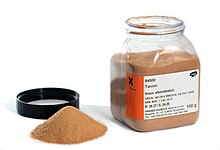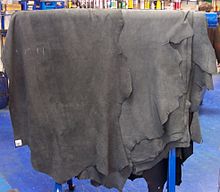Tannins

The tannins (from the French tanin tannin) are vegetable tannins that are widespread in some covering perennials, shrubs and tree leaves and other parts of plants, especially in the tropics and subtropics, and are ingested by herbivorous mammals. These compounds have a molar mass of 500-3000 u . Gallic acid often occurs as a monomer .
Tannins belong to the so-called quantitative secondary plant substances . In contrast to qualitative active ingredients ( alkaloids ), they have a broader range of defense against herbivores ( herbivores ), as they probably mainly affect digestion by deactivating proteins.
Composition and properties
From a chemical point of view, they are polyhydroxyphenols . They are in water, ethanol and acetone soluble and contain sufficient ortho -ständige phenolic hydroxyl groups to cross-links between macromolecules such as proteins , cellulose and pectin to form. Such cross-links can inhibit the activity of plant enzymes and plant organelles and ensure durability and protection against microorganisms ( tanning ) in leather production .
The vegetable tannins vary significantly in their chemical structure and biological activity. Tannins with strong absorption properties are generally found in the vacuoles, separated from the protoplasm of the plants. The physiological activity results from the selective binding of the tannins to proteins, especially to large and proline-rich molecules with an open conformation.
Tannins are divided into two groups based on their chemical properties
- hydrolyzable tannins ( gallotannins and ellagitannins ) and
- condensed tannins ( catechin tannins); also known as fused proanthocyanidins
The former can be hydrolyzed to glucose , other polyhydric alcohols, gallic acid or ellagic acid. Corilagin is an example of a hydrolyzable tannin . Condensed tannin consists of flavonoid phenols polymerized with one another, such as catechins , epicatechins , anthocyanins , etc. They are correspondingly polymers whose monomeric units consist of phenolic flavans, mostly catechins (flavan-3-ol).
Tannins can inactivate a wide variety of viruses.
Occurrence

Tannins are among the anti-nutrients that various nutrient-rich plants that are also used in human nutrition (legumes such as lima beans ) protect themselves from predators .
They are found in the wood and the bark of oak , birch and chestnut , in the pericarp of walnut, the pods of divi-divi tree ( Caesalpinia coriaria ) in Sumachgewächsen , in the fruit of the persimmon -tree and Sorbus domestica , cherry plum , Trillo, Valonea , bloodroot , in grapes, quinces and in vegetable galls . These substances are also produced by acacias such as the gum arabic tree to deter potential predators . Monomeric groups of tannins are also found in hops and in black and green tea , such as catechin in tea .
Tannins in foods
Wine
The content of tannins and their structure are a decisive factor for the quality of a wine . It is sometimes mistakenly assumed that red wines have a longer or shorter shelf life depending on the tannin content. Tannin prevents the oxidation of the wine, but nowadays this can also be achieved by adding potassium disulfite (potassium pyrosulfite). Tannin gives the wine a characteristically rough note of dryness, the so-called astringency . It is also carried over from oak barrels to wine ( barrique ) if these have not been made wine green . However, the supply of oxygen also promotes the polymerisation with anthocyanins , so that the tannin content of the wine is usually lower after the barrel aging than before. The tannin content of a wine decides less about the shelf life than about how long it needs to be stored: In the course of bottle aging, the tannins polymerize with anthocyanins to form long-chain molecules that do not have astringent effect. The astringency of the wine is steadily decreasing, which makes the wine more pleasant to drink (see drinking maturity ). The prerequisite for this is the presence of a sufficient concentration of anthocyanins (dyes).
Today oenology knows more than 30 different tannins. Some are important for the quality of the wine, others are classified as unfavorable. In principle, tannins play a greater role in red wines than in white wines, since tannins are always extracted from the berry skins with the coloring agents. Late grape harvest and high physiological ripeness ensure that tannins are ripe and perceived as soft. Immature tannins, on the other hand, taste green, aggressive and furry.
tea
Black and even more green tea also contain tannins, which explains their tart taste. The tannins are only released after a certain steeping time (more than two minutes).
Health effects
- bloating and constipating effect
- Obstruction of the absorption of certain drugs (such as digitalis ) through the intestinal lining
- Hindrance to the absorption of iron
- Hindrance to the absorption of calcium
use
The main technical use of the tannins is in leather production (tannery), where they are used as tannins to cross-link the collagen molecules and thus to increase the shelf life and protect against microorganisms. Tannins are still used as rust converters , the water solubility and environmental compatibility being advantageous compared to other active ingredients. In the chemical industry, tannins are used to produce gallic acid and pyrogallol .
By condensation with suitable crosslinking agents (for example formaldehyde ) to form high molecular weight condensation products, binders for bonding wood-based materials can be produced. However, these binders have so far not been able to establish themselves technically and economically over aminoplasts .
As pronounced antioxidants , they are used as food supplements and are also used for food preservation . They also have an antiviral and antibacterial effect .
In medicine, tannins are used because of their astringent effect as a hemostat , as an antiseptic or to treat excessive salivation ( hypersalivation ). In folk medicine, the expectorant effect is also used, through oak bark in Europe (for baths) and the bark of the gum arabic tree in Africa.
Web links
- Tannin , Weinkenner.de
- The Tannin Handbook - Tannin Chemistry (English)
Individual evidence
- ↑ Ernst Steinegger, Rudolf Hansel: Pharmakognosie. 5th edition, Springer, 1992, ISBN 978-3-662-09268-2 , p. 404, limited preview in the Google book search.
- ↑ K. Ueda, R. Kawabata, T. Irie, Y. Nakai, Y. Tohya, T. Sakaguchi: Inactivation of Pathogenic Viruses by Plant-Derived Tannins: Strong Effects of Extracts from Persimmon (Diospyros kaki) on a Broad Range of Virus. In: PLOS ONE . 8 (1), 2013, p. E55343. doi: 10.1371 / journal.pone.0055343 . Epub 2013 Jan 25. PMID 23372851
- ↑ EO Adeparusi: Effect of processing on the nutrients and anti-nutrients of lima bean (Phaseolus lunatus L.) flour. In: food. April 2001, pp. 94-96. PMID 11379294
- ↑ Anti-nutritional ingredients in legume seeds ( Memento from August 19, 2009 in the Internet Archive ) on: genres.de
- ↑ Tannins. In: Hans Zoebelein (Ed.): Dictionary of Renewable Resources. 2nd Edition. Wiley-VCH, Weinheim / New York 1996, ISBN 3-527-30114-3 , p. 300.
- ↑ Hans Heinz Naumann u. a. (Ed.): Oto-Rhino-Laryngologie in Clinic and Practice. Volume 2, Stuttgart 1992, ISBN 3-13-676601-6 , p. 414.


